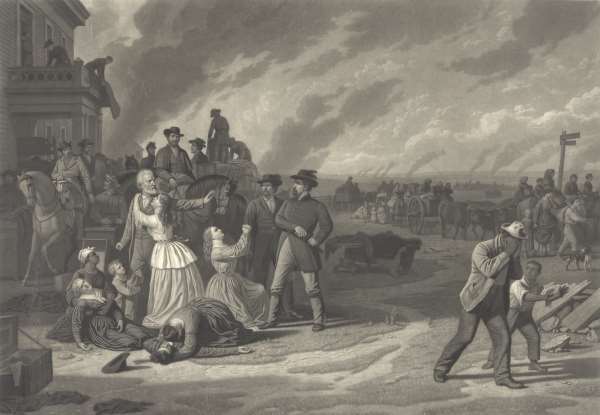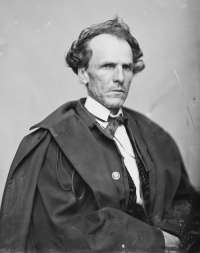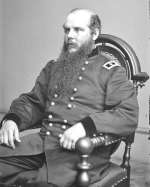Search:
Powered by
Website Baker
District of the Border General Orders, No. 11 |
| Posted by The Muse (themuse) on Aug 25 2013 |


In response to Quantrill’s Raid on Lawrence, Kansas, The Federal commander of the District of the Border, Brigadier-General Thomas Ewing, issued General Orders, No. 11 on August 25, 1863.
It had been been three days earlier when Ewing had met with Senator James H. Lane on the trail in pursuit of Quantrill’s raiders. There was a heated discussion. Lane had been one of Quantrill’s targets in Lawrence and had barely escaped with his life. Lane blamed Ewing for the raid and threatened to raise a large militia force to invade and punish Missouri for the raid. Ewing was able to talk Lane down by describing his plan to have all Missouri citizens forcibly removed from the border counties under his command. Lane concluded their conversation with the following statement. 1
You are a dead dog if you fail to issue that order as agreed between us.
“I Send General Orders, No. 11”
Following Quantrill's raid on Lawrence, Major-General John M. Schofield realized that more drastic measures were going to be necessary in order to defeat the guerrillas in Missouri. On August 25, Schofield sent the draft of an order to Brigadier-General Thomas Ewing, Jr. In the draft, Schofield wrote that “the disloyal people of Jackson, Cass, and Bates Counties” would be banished from the area and their property destroyed or appropriated for Federal use. 2
But Brigadier-General Thomas Ewing, Jr. had already acted and issued District of the Border, General Orders, No. 11. After receiving Schofield's message, Ewing immediately replied informing Schofield of the order. 3
I send in inclosed paper General Orders, No. 11, which I found it necessary to issue at once. The excitement in Kansas is great, and there is (or was before this order) great danger of a raid of citizens for the purpose of destroying the towns along the border. My political enemies are fanning the flames, and wish me for a burnt-offering to satisfy the just passion of the people.
District of the Border, General Orders, No. 11
The complete text of the District of the Border, General Orders, No. 11 issued on August 25, 1863: 4
-
All persons living in Jackson, Cass, and Bates Counties, Missouri, and in that part of Vernon included in this district, except those living within 1 mile of the limits of Independence, Hickman Mills, Pleasant Hill, and Harrisonville, and except those in that part of Kaw Township, Jackson County, north of Brush Creek and west of the Big Blue, are hereby ordered to remove from their present places of residence within fifteen days from the date hereof. Those who, within that time, establish their loyalty to the satisfaction of the commanding officer of the military station nearest their present places of residence will receive from him certificates stating the fact of their loyalty, and the names of the witnesses by whom it can be shown. All who receive such certificates will be permitted to remove to any military station in this district, or to any part of the State of Kansas, except the counties on the eastern border of the State. All others shall remove out of this district. Officers commanding companies and detachments serving in the counties named will see that this paragraph is promptly obeyed.
-
All grain and hay in the field or under shelter in the district from which the inhabitants are required to remove within reach of military stations after the 9 day of September next will be taken to such stations and turned over to the proper officers there, and report of the amount so turned over made to district headquarters, specifying the names of all loyal owners and the amount of such produce taken from them. All grain and hay found in such district after the 9 day of September next not convenient to such stations will be destroyed.
-
The provisions of General Orders, No. 10, from these headquarters will be at once vigorously executed by officers commanding in the parts of the district and at the stations not subject to the operation of Paragraph I of this order, and especially in the towns of Independence, Westport, and Kansas City.
-
Paragraph III, General Orders, No. 10, is revoked as to all who have borne arms against the Government in this district since the 21 day of August, 1863.
“He Is Acting Wisely”
 In his memoir, John M. Schofield published what he had written in his journal following Ewing issuing Order Number 11: 5
In his memoir, John M. Schofield published what he had written in his journal following Ewing issuing Order Number 11: 5
Went to Westport yesterday. Met several of the leading loyal citizens; all agree that Genl. Ewing's order No. 11 is wise and just—in fact a necessity. I have yet to find the first loyal man in the border counties who condemns it. They are also warm in their support of Genl. Ewing, and deprecate his removal. I am satisfied he is acting wisely and efficiently.
“A War of Extermination”
Because of its timing, the consensus across the nation was that Order Number 11 was issued in response to Quantrill's raid on Lawrence, Kansas. This article appeared in the Richmond Daily Dispatch on September 1, 1863: 6
Quantrell's raid upon Lawrence, Kansas, seems to have provoked a war of extermination against the people of Northern Missouri … An order has been issued from headquarters, at Kansas City, which, if carried out, will depopulate nearly the whole of the three counties in Missouri lying closest to the Kansas line.
It was a fact that many of the Federal troops (about 60 percent) under Ewing's command in the District of the Border were Kansas volunteers. Forty percent of the companies located at the Missouri stations were companies of Kansas volunteers. This would add to the severity with which Order Number 11 was enforced. In addition to the Federal volunteers, there were six companies, numbering about 40 men each, of citizens of Kansas; part of the companies organized under militia laws of the State, and part who are merely sheriff's posses, to whom Major-General James G. Blunt has issued arms and rations, and most of whom are mounted. These were the “Kansas Redlegs.” At the end of July in 1863, Ewing had around 3,100 men in his command. The border counties of Missouri would suffer as a result of Order Number 11. 7
Image Credits
-
Thomas Ewing, Jr. [LC-DIG-cwpbh-03226, image courtesy of the Library of Congress]
-
Martial Law by George Caleb Bingham [LC-DIG-pga-02633, image courtesy of the Library of Congress]
-
James H. Lane [LC-DIG-cwpbh-04323, image courtesy of the Library of Congress]
-
John M. Schofield [LC-DIG-cwpb-05934], image courtesy of the Library of Congress]
-
James G. Blunt [LC-DIG-cwpb-06820], image courtesy of the Library of Congress]
References
Castel, Albert E. William Clarke Quantrill : his life and times. Norman: University of Oklahoma Press, 1999.
Connelley, William E. Quantrill and the border wars. Cedar Rapids, Iowa: The Torch Press, 1910.
Nichols, Bruce. Guerrilla Warfare in Civil War Missouri: Volume II, 1863. Jefferson, North Carolina: McFarland & Company, Inc. 2007. [p. 213-215]
Schofield, John M. Forty-six Years in the Army. Volume One. New York: The Century Co., 1897.
United States War Department, The War of the Rebellion: A Compilation of the Official Records of the Union and Confederate Armies, 70 volumes in 4 series. Washington, D.C.: United States Government Printing Office, 1880-1901. Series 1, Volume 22.
Dick Titterington, August 25, 2013.
1Nichols, Guerrilla Warfare in Civil War Missouri, 1863, p. 220-221; Connelley, Quantrill and the Border Wars, p. 418.
2OR Series 1, Vol. XXII, Part 2, p. 471-472.
3OR Series 1, Vol. XXII, Part 2, p. 472.
4OR Series 1, Vol. XXII, Part 2, p. 473.
5Schofield, Forty-six Years in the Army, p. 83.
6Richmond Daily Dispatch, 9/1/1863.
7OR Series 1, Vol. XXII, Part 2, p. 322-323, 416, 419-420.
Last changed: Aug 25 2013 at 9:44 AM
Back